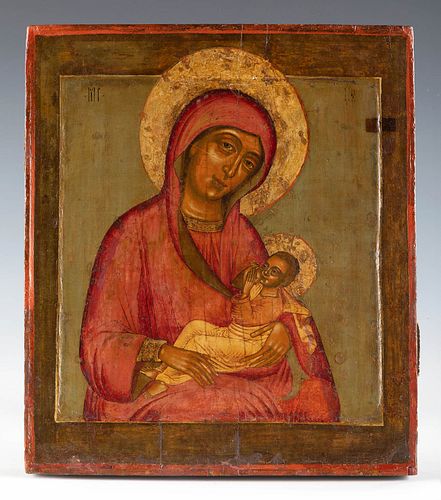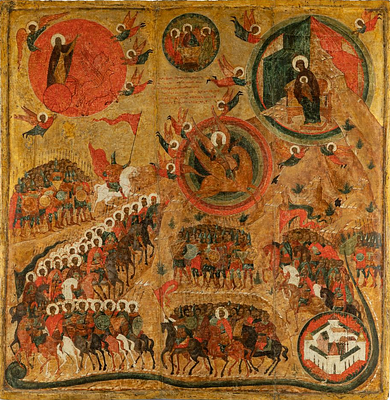Russian school, 19th century. "The Virgin of the Milk". Tempera, gold leaf on panel.
Lot 40
About Seller
Setdart Auction House
Carrer Aragó 346
Barcelona
Spain
Setdart Subastas was born in 2004 and is currently the first online art auction in Spain with solidity, prestige and reliability guaranteed by our more than 60,000 users. Setdart has a young, dynamic and enterprising team ready to successfully manage the purchase and sale of art works through custom...Read more
Categories
Estimate:
EUR€1,000 - EUR€1,200
$1,075.27 - $1,290.32
Absentee vs Live bid
Two ways to bid:
- Leave a max absentee bid and the platform will bid on your behalf up to your maximum bid during the live auction.
- Bid live during the auction and your bids will be submitted real-time to the auctioneer.
Bid Increments
| Price | Bid Increment |
|---|---|
| EUR€0 | EUR€10 |
| EUR€200 | EUR€25 |
| EUR€500 | EUR€50 |
| EUR€1,000 | EUR€100 |
| EUR€3,000 | EUR€200 |
| EUR€5,000 | EUR€500 |
| EUR€10,000 | EUR€1,000 |
| EUR€20,000 | EUR€2,000 |
| EUR€50,000 | EUR€5,000 |
About Auction
By Setdart Auction House
Sep 23, 2021
Set Reminder
2021-09-23 10:00:00
2021-09-23 10:00:00
America/New_York
Bidsquare
Bidsquare : RUSSIAN ICONS
https://www.bidsquare.com/auctions/setdart-auction-house/russian-icons-7431
Setdart Auction House sofia@setdart.com
Setdart Auction House sofia@setdart.com
- Lot Description
Russian school, 19th century. "The Virgin of the Milk". Tempera, gold leaf on panel. Measurements: 31,5 x 18 cm. Images of the Virgin Mary suckling the Christ Child have been known in Eastern Christian art since antiquity. This theme became especially popular in post-Byzantine Italo-Greek painting. This typology has been known in Russia since 1392, and was a priori called the Mother of God of Bari, after the Italian city of Bari, from where the original icon was brought to the Cathedral of the Annunciation in the Moscow Kremlin. This icon was eventually lost, but its very few later versions have survived, which form the basis of this typology of the Mother of God, to which the lot of interest belongs. This icon is executed according to the traditional canon. The seated Virgin is depicted half-length, with her face and torso rotated by three-quarters. The Child Jesus rests in his mother's arms, suckling at her breast, one of the two versions of the representation of the Child Jesus, who can also appear simply resting in her arms. The icon of interest has very particular aesthetic characteristics. Under a precise contemplation and study of the features, it could be concluded that this anonymous master was inspired by the models of the earliest icons of the Novgorod school, around the 12th century. In particular, this Mother of God has features that coincide with the features of the famous icon "Angel with golden hair" or "Archangel Michael or Gabriel", painted in Novgorod around the second half of the 12th century. Like that angel, the Virgin's eyes are exaggeratedly larger than the rest of her facial features. The outer corners of the eyes have a slight downward tendency. The upper eyelids are half closed, and half of the pupil is hidden beneath it. The lower eyelid protrudes and has a characteristic shadow. The corners of the lips have two subtle points of shadow, which create the appearance of a warm and affectionate smile. The very pronounced eyebrows, in a dark tone, create a continuous line with the nose, also marked by the dark shadow. The background of the icon is painted in a greenish tone, a tone that came into fashion especially in the 17th century for painting large backgrounds. But this does not mean that it was not used for this purpose before. For example, the icon of the archangel, mentioned above, also has a green background, in a different tone. Of course, the present lot, within the canonical aspect of the composition, has a series of very particular characteristics that make it stand out and make it a discovery of orthodox painting.
- Shipping Info
-
In-house shipping available. Please inquire at admin@setdart.com.
-
- Buyer's Premium



 EUR
EUR CAD
CAD AUD
AUD GBP
GBP MXN
MXN HKD
HKD CNY
CNY MYR
MYR SEK
SEK SGD
SGD CHF
CHF THB
THB
















